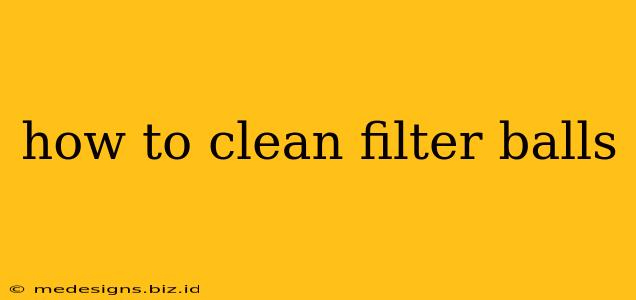Keeping your swimming pool, pond, or aquarium water sparkling clean relies heavily on efficient filtration. Filter balls are a popular choice for many water features, offering a cost-effective and environmentally friendly alternative to other filter media. However, to maintain their effectiveness, regular cleaning is crucial. This guide will walk you through the process of cleaning filter balls, ensuring your water stays crystal clear.
Understanding Filter Ball Cleaning: Why It's Essential
Dirty filter balls become clogged with debris, reducing their filtering capacity. This leads to several problems:
- Poor water clarity: Cloudy or murky water is the most obvious sign of clogged filter balls.
- Reduced filtration efficiency: Inefficient filtration allows contaminants to remain in your water, potentially harming aquatic life or making your pool unpleasant to use.
- Increased water treatment costs: You might need to use more chemicals to compensate for poor filtration.
- Shorter lifespan of filter balls: Neglecting cleaning accelerates wear and tear, requiring more frequent replacements.
Regular cleaning extends the life of your filter balls, saving you money in the long run and ensuring consistently clean water.
How Often Should You Clean Filter Balls?
The frequency of cleaning depends on several factors, including:
- Water usage: Higher usage means more debris, necessitating more frequent cleaning.
- Type of water feature: Pools with more leaves and debris will require more frequent cleaning than indoor aquariums.
- Type of filter system: Some systems are more prone to clogging than others.
As a general guideline, plan to clean your filter balls every 2-4 weeks. However, regularly inspect your filter balls and clean them sooner if you notice a significant decrease in water clarity or increased pressure in your filtration system.
Methods for Cleaning Filter Balls: A Step-by-Step Guide
There are several methods you can use to clean your filter balls, ranging from simple rinsing to more thorough cleaning.
Method 1: Simple Rinsing
This is the quickest and easiest method, suitable for lightly soiled filter balls.
- Remove the filter balls: Carefully remove the filter balls from your filter system.
- Rinse with a garden hose: Use a gentle stream of water to rinse away loose debris. Avoid using high pressure, as this can damage the filter balls.
- Inspect for damage: Check the filter balls for any signs of damage or wear. Discard any damaged balls.
- Reinstall the filter balls: Once rinsed, carefully reinstall the filter balls in your filter system.
Method 2: Soaking and Scrubbing
This method is suitable for moderately soiled filter balls.
- Remove and rinse: Remove the filter balls and rinse them with a garden hose as described above.
- Soak in a cleaning solution: Soak the filter balls in a solution of mild detergent and water for 30-60 minutes. Avoid harsh chemicals.
- Scrub gently: Use a soft brush or sponge to gently scrub away any remaining debris.
- Rinse thoroughly: Rinse the filter balls thoroughly with clean water to remove all traces of detergent.
- Air dry: Allow the filter balls to air dry completely before reinstalling them in your filter system.
Method 3: Backwashing (If Applicable)
Some filter systems allow for backwashing, which reverses the flow of water to flush out debris. Check your filter system's manual to see if backwashing is an option.
Maintaining Clean Filter Balls: Proactive Measures
To minimize the need for frequent cleaning, consider these preventative measures:
- Pre-filtration: Use a skimmer or leaf net to remove large debris before it reaches your filter balls.
- Regular maintenance: Regularly inspect your filter system for any leaks or blockages.
- Proper chemical balance: Maintaining the proper chemical balance in your water helps prevent the buildup of algae and other contaminants.
When to Replace Filter Balls
Even with regular cleaning, filter balls will eventually wear out and need replacing. Replace your filter balls when they become excessively damaged, brittle, or lose their effectiveness despite cleaning. Look for signs such as significant reduction in water clarity despite cleaning or increased pressure in your filtration system.
By following these steps and adopting proactive maintenance strategies, you can keep your filter balls clean and extend their lifespan, ensuring consistently clean and clear water in your swimming pool, pond, or aquarium.
